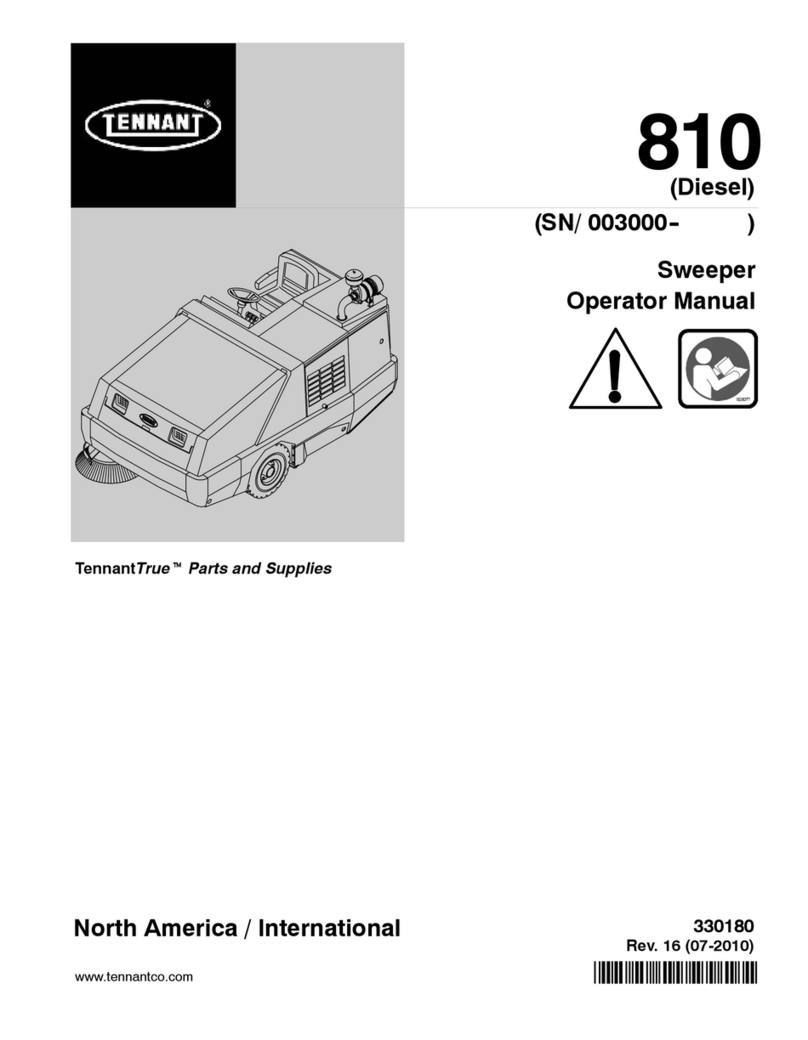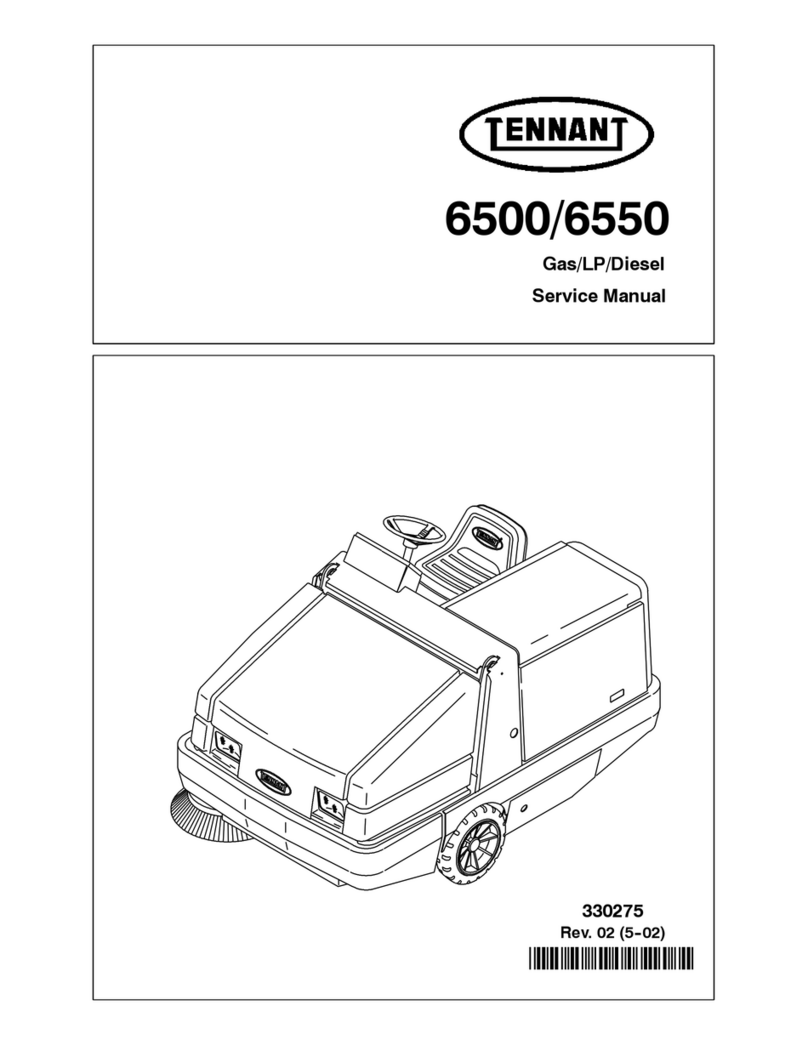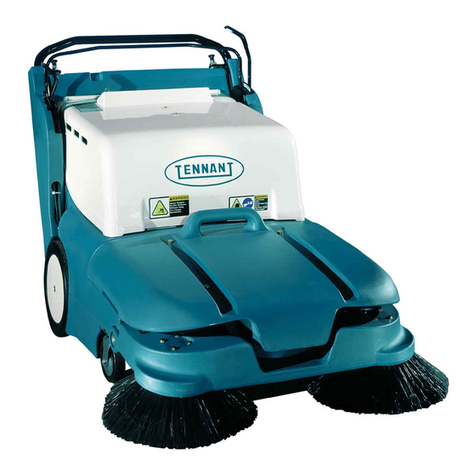
GENERAL INFORMATION
iii
140 MM130 (12--96)
CONTENTS
Page
GENERAL INFORMATION i..............
SAFETY PRECAUTIONS i............
SPECIFICATIONS 1--1.....................
MACHINE SPECIFICATIONS 1--3.........
POWER TYPE 1--3...................
POWER TRAIN 1--3..................
SUSPENSION SYSTEM 1--3..........
SYSTEM FLUID CAPACITIES 1--3.....
GENERAL MACHINE
DIMENSIONS/CAPACITIES 1--3....
MACHINE WEIGHTS 1--3.............
GENERAL MACHINE
PERFORMANCE 1--3..............
MACHINE DIMENSIONS 1--4.............
OPERATION 2--1..........................
PREPARATION FOR OPERATION 2--3....
AFTER UNCRATING AND BEFORE
OPERATING THE MACHINE: 2--3...
OPERATION OF CONTROLS 2--4........
MACHINE COMPONENTS 2--4........
CLUTCH CONTROL HANDLE 2--5.....
MAIN BRUSH LIFT HANDLE 2--5......
SIDE BRUSH 2--5....................
MAIN BRUSH REMOVAL LEVER 2--5..
ENGINE STARTER CORD 2--5........
ENGINE CHOKE 2--6.................
ENGINE THROTTLE LEVER 2--6......
IGNITION SHORTING CLIP 2--6.......
MACHINE OPERATION 2--7..............
NORMAL SWEEPING OPERATION 2--7
PRE-START CHECKLIST 2--7.......
TO START MACHINE 2--7..........
TO SWEEP 2--7...................
TO DUMP HOPPER 2--8...........
POST OPERATION CHECKLIST --
ENGINE OPERATING 2--8....
TO STOP MACHINE 2--8...........
POST OPERATION CHECKLIST --
ENGINE STOPPED 2--8......
MACHINE TROUBLESHOOTING 2--9..
MACHINE STORAGE 2--11................
STORING MACHINE 2--11.............
MAINTENANCE 3--1.......................
RECOMMENDED FIRST 5--HOUR
MACHINE INSPECTION 3--3..........
MAINTENANCE CHART 3--4.............
Page
ENGINE 3--5...........................
ENGINE LUBRICATION 3--5...........
COOLING SYSTEM 3--5..............
AIR INTAKE SYSTEM 3--5............
AIR FILTER 3--5...................
TO CLEAN AIR FILTER
ELEMENT 3--5.................
FUEL SYSTEM 3--6..................
FUEL TANK 3--6...................
CARBURETOR CHOKE 3--6........
CARBURETOR 3--6................
IGNITION SYSTEM 3--6...............
SPARK PLUG 3--6.................
IGNITION SYSTEM 3--7............
TO CHECK AND ADJUST
STANDARD IGNITION
SYSTEM 3--7...............
CYLINDER HEAD 3--8................
CYLINDER HEAD 3--8.............
VALVE TAPPET CLEARANCE 3--8..
BRUSHES 3--9..........................
MAIN BRUSH 3--9....................
TO REMOVE MAIN BRUSH 3--9....
TO INSTALL MAIN BRUSH 3--9.....
TO CHECK AND ADJUST
MAIN BRUSH PATTERN 3--10....
SIDE BRUSH 3--10....................
TO REMOVE SIDE BRUSH 3--11.....
TO INSTALL SIDE BRUSH 3--11.....
TO ADJUST SIDE BRUSH 3--11......
DEBRIS HOPPER AND DUST FILTER 3--12.
DEBRIS HOPPER 3--12................
TO EMPTY HOPPER 3--12..........
TO ADJUST HOPPER FLOOR
CLEARANCE 3--12..............
REAR GUIDE WHEELS 3--12...........
TO ADJUST REAR GUIDE
WHEELS 3--12..................
HOPPER DUST FILTER 3--13...........
TO REMOVE DUST FILTER 3--13....
TO INSTALL DUST FILTER 3--14.....
SKIRTS AND SEALS 3--15................
SIDE DUST SKIRTS 3--15..............
TO ADJUST SIDE DUST SKIRTS 3--15
TO REPLACE SIDE DUST
SKIRTS 3--15...................
HOPPER SIDE SEALS 3--16............
TO REPLACE HOPPER SIDE
SEALS 3--16....................
REAR BRUSH SKIRT 3--16.............
TO REPLACE REAR BRUSH
SKIRT 3--16.....................



















































